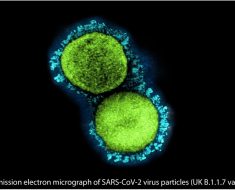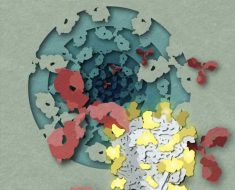In a recent study published Cell Reports Physical Science, scientists have described a virus-blocking textile that prevents transmission of severe acute respiratory syndrome coronavirus 2 (SARS-CoV-2) via repulsive Coulomb force and human body triboelectric energy harvesting.

Study: Virus blocking textile for SARS-CoV-2 using human body triboelectric energy harvesting. Image Credit: Harry Wedzinga/Shutterstock
Background
With the progression of the coronavirus disease 2019 (COVID-19) pandemic, several potent vaccines have been made and rolled out to protect the global population from deadly SARS-CoV-2. Several non-pharmaceutical control measures, such as face masks and personal protective equipment (PPE), have also been used to prevent respiratory droplets/aerosols from entering the body.
A wide variety of respiratory filtration units, including electrostatic filters, surgical masks, and cotton textiles, have been used widely during the pandemic. However, there are certain drawbacks to these filters.
For instance, the effectiveness of electrostatic filters reduces rapidly due to the loss of static charges in a few hours. Similarly, surgical masks and cotton masks fail to provide sufficient protection when the respiratory flow rate is high, or the diameter of respiratory particles is small. Thus, the development of effective non-pharmaceutical control measures is highly needed to provide immediate protection against viral transmission.
In the current study, the scientists have developed a virus-blocking textile that repulses SARS-CoV-2-containing respiratory particles by applying repulsive Coulomb force (electric field). Moreover, they have assessed the electrical charges of SARS-CoV-2 and respiratory particles. Preventing respiratory particles through repulsion has certain advantages. This mitigation strategy prevents the virus from reaching the filter and thus, reduces the chance of contact infection by contamination.
Virus-blocking textile
The scientists measured the electrical charges of the virus using Faraday cup and electrometer. The findings revealed that SARS-CoV-2-contaning aerosols are negatively charged, which could be due to the negative charges of viral spike protein and phospholipids on the viral envelope.
They designed the virus-blocking textile as a textile capacitor, including two conductive silk textiles coated with a polymer mixture and an insulating filter.
For continuously blocking virus-containing respiratory particles, they charged the virus-blocking textile using human body triboelectric energy harvesting. The human body generates triboelectric charges during comprehensive motions (hand tapping, walking, and fluttering of clothing) when the skin makes repeated contacts and separations with nearby materials.
The charging of virus-blocking textile using human body triboelectric energy harvesting led to the generation of negative electrical charges on the front-side of silk textile. This made the textile capable of repulsing negatively charged viral aerosols through repulsive Coulomb force. This is the basic working principle of virus-blocking textile.
By conducting a panel of experiments, the scientists observed that the human body can generate high output current reaching the highest peak of 212.9 μA. Given this finding, the scientists considered that harvesting human body triboelectric energy can be a novel approach for continuously supplying electrical power to the virus-blocking textile.
Effectiveness of virus-blocking textile
The scientists placed the virus-blocking textile inside an acrylic chamber and introduced SARS-CoV-2 aerosol (3 μm diameter) into the chamber to mimic respiratory contact. They charged the textile using rectified triboelectric output current by contact and separation between different materials. This mimics human body-generated triboelectric output.
They subsequently measured the amount of viral RNA in the front chamber, virus-blocking textile, and back chamber. The findings revealed that the virus-blocking textile can prevent SARS-CoV-2 transmission by 99.9%. Moreover, a 13-fold reduced viral RNA was detected in the textile. In contrast, a significantly increased viral RNA level was detected in the front chamber. This indicates that the textile is capable of effectively repulsing viral aerosols.
Study significance
The study describes the development and validation of a negatively-charged virus-blocking textile that effectively repulses negatively-charged SARS-CoV-2-containg aerosols. The negative charging of the textile has been done using human body-generated triboelectric output.
The textile is capable of blocking SARS-CoV-2 transmission by 99.9%. Moreover, the textile has high breathability, washability, and durability. Given the study findings, the scientists believe that the textile can be effectively used as a face mask or filter to prevent SARS-CoV-2 infection.
-
Kang, M. et al. (2022) "Virus blocking textile for SARS-CoV-2 using human body triboelectric energy harvesting", Cell Reports Physical Science, p. 100813. doi: 10.1016/j.xcrp.2022.100813. https://www.sciencedirect.com/science/article/pii/S2666386422000832
Posted in: Medical Science News | Medical Research News | Disease/Infection News
Tags: Cell, Contamination, Coronavirus, Coronavirus Disease COVID-19, covid-19, Pandemic, Personal Protective Equipment, PPE, Protein, Respiratory, RNA, SARS, SARS-CoV-2, Severe Acute Respiratory, Severe Acute Respiratory Syndrome, Skin, Spike Protein, Syndrome, Virus, Walking

Written by
Dr. Sanchari Sinha Dutta
Dr. Sanchari Sinha Dutta is a science communicator who believes in spreading the power of science in every corner of the world. She has a Bachelor of Science (B.Sc.) degree and a Master's of Science (M.Sc.) in biology and human physiology. Following her Master's degree, Sanchari went on to study a Ph.D. in human physiology. She has authored more than 10 original research articles, all of which have been published in world renowned international journals.
Source: Read Full Article





